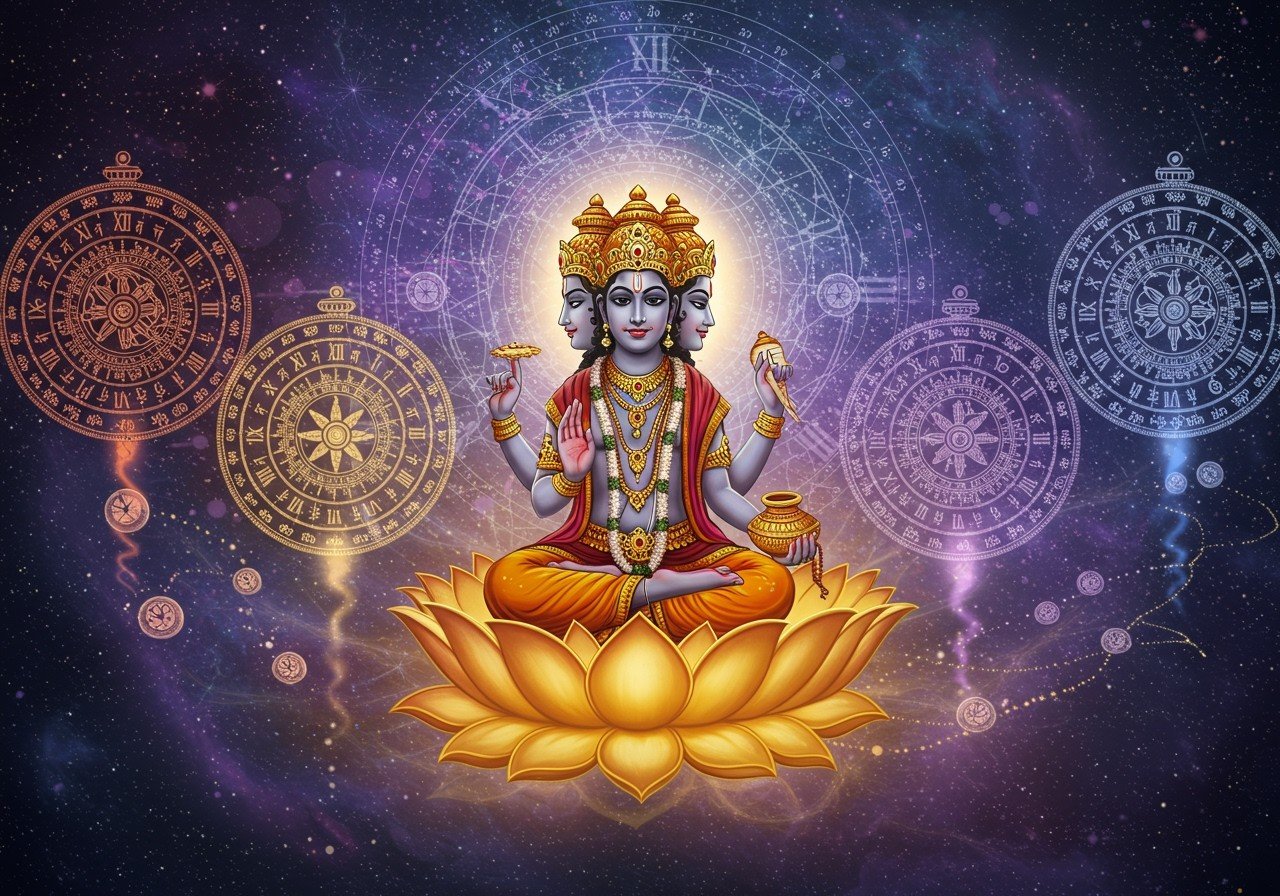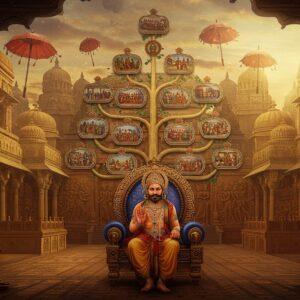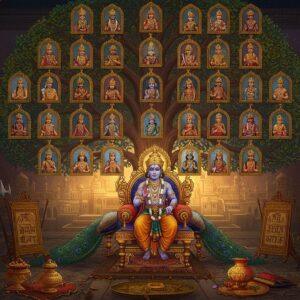
In Hindu tradition, understanding the units of time is essential for rituals and astrology. Ancient India’s timekeeping methods still play a significant role in cultural and religious practices today. These time units help culturally rooted Indians value tradition while maintaining authenticity. For a deeper dive into Hindu philosophy and symbolism, explore our articles on Hindu Philosophy and Hindu Symbols.
Time in Hindu Cosmology: A Cyclical View
In Hindu cosmology, time isn’t a straight line; it’s a circle, always turning, always renewing. Unlike the Western idea of linear time, Hindu thought embraces a cyclical view, symbolized by the four Yugas—Satya, Treta, Dvapara, and Kali. Each Yuga represents a distinct phase in the cycle of human virtue. Lord Brahma, the creator, plays a central role, with time itself measured in his divine days and years. The concept of a Kalpa, a cosmic day of Brahma, helps us grasp these immense cosmic cycles. You can delve deeper into sacred Hindu symbols like Rudraksha and Tulsi in our dedicated article here.
Hindu Time Units Explained
Imagine time not just as hours and days, but as a rich tapestry of moments, from the blink of an eye to the lifespan of the universe. Our ancestors, with their deep understanding of the cosmos, created a fascinating system to measure it all.
Basic Units: The Building Blocks of Time
-
Truti: The smallest unit, a mere flicker lasting about 29.6 to 0.30 microseconds. It’s the very heartbeat of time, almost too small to grasp.
-
Renu: Sixty Trutis make a Renu, roughly 18 microseconds. These tiny units build upon each other, forming the foundation of Hindu timekeeping.
-
Lava: Sixty Renus form a Lava, approximately 1080 microseconds. Think of the swiftness of a blink, a Nimesha, and you have a Lava.
-
Nimesha: Often defined as the blink of an eye, the Nimesha gives us a more relatable unit of time. It connects us to the human experience of time’s flow.
-
Kashtha: Around 8 seconds long, a Kashtha feels more substantial, something we can easily perceive in our daily lives.
-
Kala: Spanning a couple of minutes, a Kala allows us to measure short durations, like the time it takes for a prayer or a simple task.
-
Ghatika: Approximating 24 minutes, a Ghatika helps us structure our day. Imagine it as a smaller segment of the day, a manageable chunk of time.
-
Muhurta: Roughly 48 minutes, a Muhurta is significant for rituals and daily routines. A day is divided into 30 Muhurtas, guiding many traditional practices.
Days, Months, and Years: The Familiar Rhythms
We then move to the more familiar units of Ahoratram (a sidereal day), the Day of Devas (equivalent to a human year), and the Month of Pitris (equivalent to a human day). These concepts highlight the relativity of time across different realms of existence, a core principle in Hindu cosmology.
Yugas: The Grand Epochs
-
Satya Yuga (Krita Yuga): The golden age, a time of virtue and harmony, lasting a staggering 1,728,000 human years. It sets the ideal for human conduct and societal order.
-
Treta Yuga: Following Satya Yuga, Treta Yuga spans 1,296,000 human years. It marks a slight decline in virtue and the beginning of challenges.
-
Dvapara Yuga: Continuing the cyclical descent, Dvapara Yuga lasts 864,000 human years. It’s a time of increasing moral ambiguity and conflict.
-
Kali Yuga: The current epoch, Kali Yuga, extends for 432,000 years. It represents the age of strife and decline, where darkness and ignorance prevail.
A complete cycle of these four Yugas forms a Chaturyuga or Mahayuga, lasting 4.32 million years, a testament to the vastness of Hindu time cycles.
Larger Cycles: The Cosmic Dance of Time
-
Manvantara: A Manvantara is the reign of a Manu, a progenitor of humankind, lasting about 306.72 million years. Each Kalpa, a larger cycle, contains 14 Manvantaras, each representing a different phase in cosmic evolution.
-
Kalpa: A Kalpa, also known as a “day of Brahma,” spans an incredible 4.32 billion years. It encompasses the entire cycle of creation, sustenance, and dissolution of the universe.
-
Day of Brahma: Equivalent to 1,000 Kalpas, a Day of Brahma is 4.32 trillion years, a truly mind-boggling span of time.
-
Lifespan of Brahma: Believed to be 100 Brahma years, this vast period represents the entire lifespan of the universe according to Hindu cosmology.
Key Concepts: Understanding the Nature of Time
-
Cyclical Time: Hinduism sees time as a continuous cycle, with no beginning or end, a wheel constantly turning through creation, sustenance, dissolution (Pralaya), and rest. This concept highlights the interconnectedness of all things and the eternal nature of existence.
-
Eternal Time: Time, or Kala, is considered eternal, a fundamental aspect of reality that transcends human comprehension. It’s a force that governs the universe, shaping its destiny and the lives of all beings.
-
Relative Time: Time is relative, flowing differently for humans, Devas, Pitris, and Brahma. This concept reminds us that our perception of time is limited and influenced by our own place in the cosmos.
-
Pralaya: Pralaya is the period of dissolution at the end of a Kalpa, where the universe is dissolved back into its primordial state before being reborn anew. It symbolizes the cyclical nature of existence and the impermanence of all things.
By understanding these units and cycles, we connect with our rich cultural heritage and deepen our spiritual awareness. Rituals and astrology reflect these timeless patterns, adding authenticity to our traditions. Whether planning a ceremony or seeking auspicious moments, these ancient measures offer profound wisdom. For a deeper understanding of Yantras and Yagyas, explore our beginner’s guide.
Poojn.in: Your Guide to Hindu Traditions
At Poojn.in, we offer a curated selection of authentic ritual items and educational resources to help you connect with these ancient time concepts. Discover:
- Panchang Calendars: Authentic panchang calendars accurately mark important Hindu time divisions and auspicious periods, guiding you in planning ceremonies and daily activities.
- Traditional Instruments: Explore traditional ghanta (bells) and other time-keeping instruments used in rituals to enhance your spiritual practice.
- Kalwa Raksha Sutra: Protect yourself with the sacred Kalwa Raksha Sutra, a pure cotton yarn thread symbolizing protection and blessings. Also available in other variations here.
- Educational Resources: Immerse yourself in the wisdom of Hindu time concepts through our informative articles and expert guidance.
- Expert Guidance: Receive personalized assistance from our knowledgeable team on performing time-based rituals correctly. We’re here to support your spiritual journey.
Visit www.poojn.in or contact us:
- Phone: 03369029784
- WhatsApp: 9476142738
As India’s largest Dashakarma bhandar, we guarantee authentic products delivered conveniently to your doorstep, making it easier to honor traditions in today’s world. You can also explore other Flammable items or Wooden Masks available at Poojn.in
-
Flammable Items: Enhance your puja ceremonies with our range of Flammable products.
-
Wooden Masks: Explore our exclusive collection of Wooden Masks.
Embrace Time: Tradition Meets Modernity
Understanding Hindu units of time bridges our past with the present. It’s not just about telling time; it’s about connecting with our roots, honoring the wisdom of our ancestors, and appreciating the timeless nature of our traditions. In today’s fast-paced world, this knowledge keeps us grounded, reminding us of the cyclical nature of existence and the deeper meaning behind our rituals. Poojn.in empowers you to integrate these ancient principles into your modern life, creating a harmonious blend of tradition and convenience.
FAQs on Hindu Time Units
Basic Units and Cosmology
What are the basic Hindu units of time? The fundamental units are the Truti, Renu, Lava, Nimesha, Kashtha, Kala, Ghatika, and Muhurta, each building upon the previous one to measure progressively longer durations. These form the basis of Hindu timekeeping, used for everything from daily routines to elaborate ceremonies.
How does Hindu cosmology relate to time? Hindu cosmology views time as cyclical, not linear. This cyclical view is exemplified by the concept of Yugas, vast epochs that repeat in a continuous cycle, each with distinct characteristics. This perspective emphasizes the interconnectedness of all things and the eternal nature of the cosmos.
Yugas and Timekeeping
What is a Yuga in Hindu units of time? A Yuga is a vast epoch, a major division of time in Hindu cosmology. There are four Yugas—Satya, Treta, Dvapara, and Kali—each with a specific length and associated qualities. Together, they form a Mahayuga, a complete cycle of time.
How is timekeeping in ancient India different from modern timekeeping? Ancient Indian timekeeping relied on observing natural phenomena and celestial movements, using units like Tithis, Nakshatras, and Yogas. Modern timekeeping, in contrast, depends on standardized clocks and calendars, offering a more precise but perhaps less nuanced understanding of time’s passage.
Muhurtas and Their Significance
What is the significance of a Muhurta in Hindu units of time? A Muhurta, approximately 48 minutes, is crucial for determining auspicious times for rituals, ceremonies, and even daily activities. Selecting the right Muhurta is believed to enhance the positive outcomes of undertakings and align actions with cosmic energies.
Why is understanding Hindu units of time important? Understanding these units is essential for anyone who follows traditional Hindu rituals and ceremonies. It allows for proper alignment of activities with cosmic cycles, fostering harmony with nature and enhancing the spiritual significance of practices.
Cultural Impact and Modern Relevance
How do Hindu units of time affect cultural practices? They deeply influence festivals, rituals, and daily routines. The timing of activities is often guided by these units, ensuring they are performed at the most auspicious times, maximizing their spiritual benefit.
Can Hindu units of time be used in modern life? Absolutely. Integrating these concepts into modern life, such as planning events during auspicious Muhurtas, can enrich our connection with tradition and bring a deeper sense of meaning to our daily lives. Pancha Kasai and Kakkal Kokkol are essential ritual items that can further enhance your connection with Hindu traditions.
Explore more on Holy Clothing and Falcon Products.


